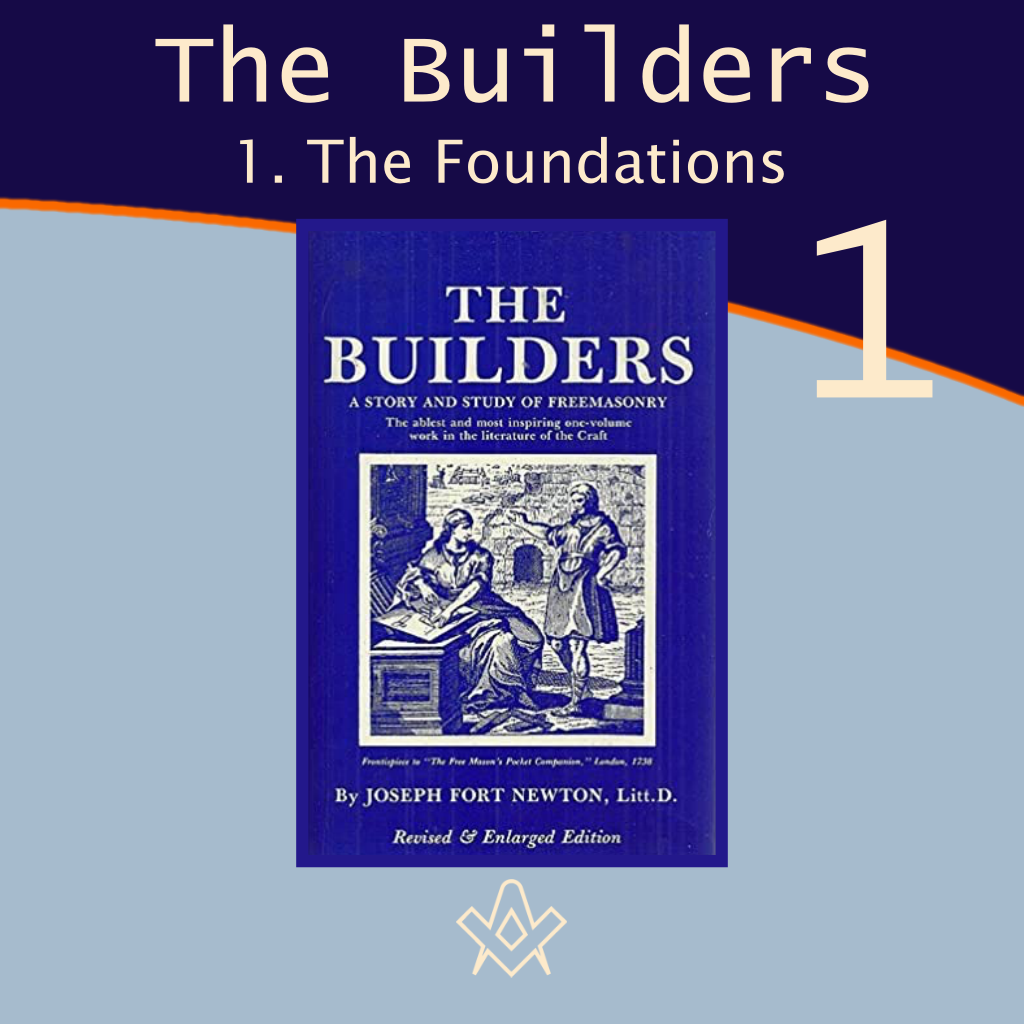In 1915, Joseph Fort Newton’s book, ‘The Builders: A Story and Study of Freemasonry’ was published.
It has become a Masonic classic in as much that it really does lay the foundations of knowledge for us to build upon.
Taking us back to the times of the ‘builders’ before the traditional history of the Craft, he explores not only the history of man’s quest to build – both literally and figuratively – but how it relates to the speculative work of the Freemason.
His insights and wisdom are as relevant today as they were over a hundred years ago and as with all good work, we start with the foundations…
“Here, then, are the real foundations of Masonry, both material and moral: in the deep need and aspiration of man, and his creative impulse; in his instinctive Faith, his quest of the Ideal, and his love of the Light.
Underneath all his building lay the feeling, prophetic of his last and highest thought, that the earthly house of his life should be in right relation with its heavenly prototype, the world-temple—imitating on earth the house not made with hands, eternal in the heavens.”
Extracted from The Builders: A Story and Study of Freemasonry
Joseph Fort Newton
The Torch Press, Iowa, 1915
Chapter 1 – The Foundations
By Symbols is man guided and commanded, made happy, made wretched.
He everywhere finds himself encompassed with Symbols, recognized as such or not recognized: the Universe is but one vast Symbol of God; nay, if thou wilt have it, what is man himself but a Symbol of God; is not all that he does symbolical; a revelation to Sense of the mystic God-given force that is in him; a Gospel of Freedom, which he, the Messiah of Nature, preaches, as he can, by word and act?
Not a Hut he builds but is the visible embodiment of a Thought; but bears visible record of invisible things; but is, in the transcendental sense, symbolical as well as real.
—THOMAS CARLYLE, Sartor Resartus
Two arts have altered the face of the earth and given shape to the life and thought of man, Agriculture and Architecture.
Of the two, it would be hard to know which has been the more intimately interwoven with the inner life of humanity; for man is not only a planter and a builder, but a mystic and a thinker.
For such a being, especially in primitive times, any work was something more than itself; it was a truth found out.
In becoming useful it attained some form, enshrining at once a thought and a mystery.
Our present study has to do with the second of these arts, which has been called the matrix of civilization.
When we inquire into origins and seek the initial force which carried art forward, we find two fundamental factors—physical necessity and spiritual aspiration.
Of course, the first great impulse of all architecture was need, honest response to the demand for shelter; but this demand included a Home for the Soul, not less than a roof over the head.
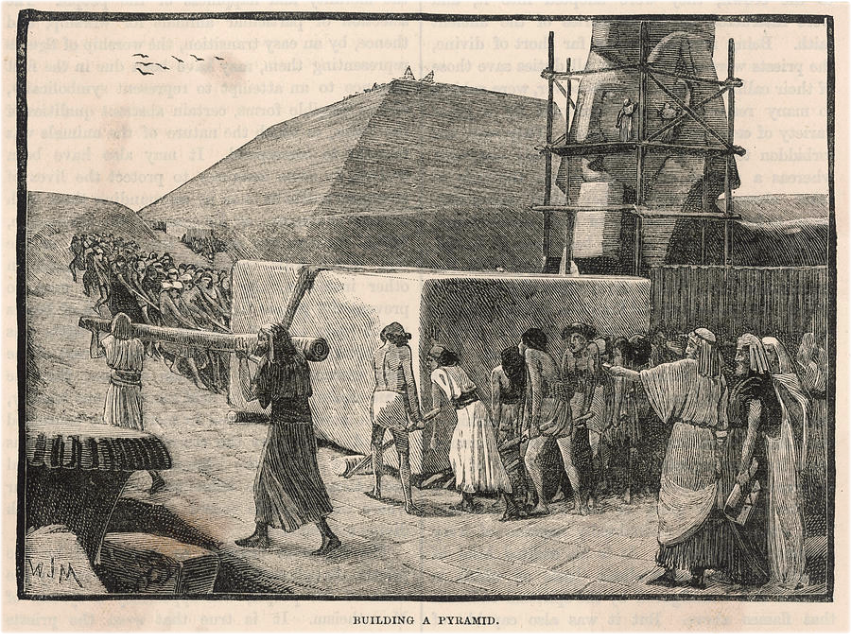
‘Building a pyramid’ – Cassell’s Illustrated Universal History, Edmund Ollier, 1882, p. 60.
IMAGE LINKED: Cassell’s Illustrated Universal History Attribution 4.0 International (CC BY 4.0)
Even in this response to primary need there was something spiritual which carried it beyond provision for the body; as the men of Egypt, for instance, wanted an indestructible resting-place, and so built the pyramids.
As Capart says, prehistoric art shows that this utilitarian purpose was in almost every case blended with a religious, or at least a magical, purpose. [1]
The spiritual instinct, in seeking to recreate types and to set up more sympathetic relations with the universe, led to imitation, to ideas of proportion, to the passion for beauty, and to the effort after perfection.
Man has been always a builder, and nowhere has he shown himself more significantly than in the buildings he has erected.
When we stand before them—whether it be a mud hut, the house of a cliff-dweller stuck like the nest of a swallow on the side of a canon, a Pyramid, a Parthenon, or a Pantheon—we seem to read into his soul.
The builder may have gone, perhaps ages before, but here he has left something of himself, his hopes, his fears, his ideas, his dreams.
Even in the remote recesses of the Andes, amidst the riot of nature, and where man is now a mere savage, we come upon the remains of vast, vanished civilizations, where art and science and religion reached unknown heights.
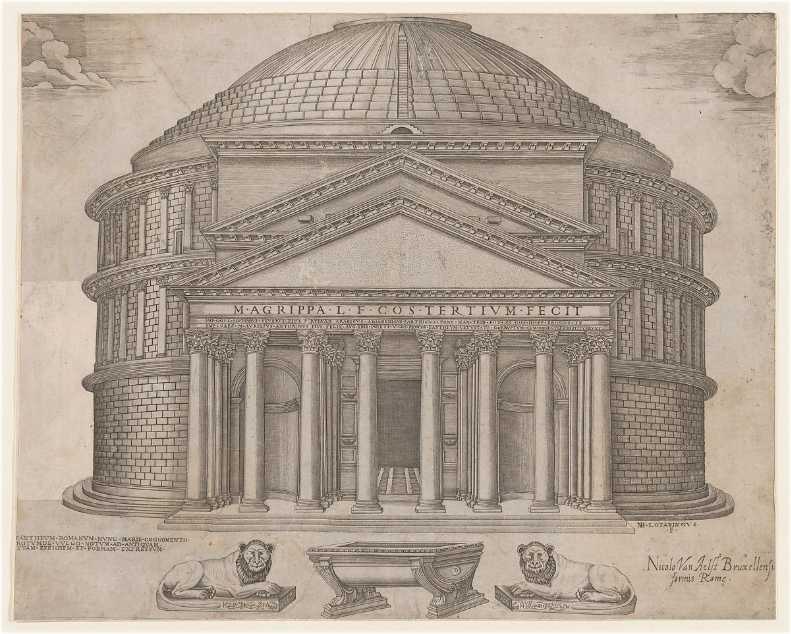
‘ Speculum Romanae Magnificentiae: The Pantheon
IMAGE LINKED: The Met Open Access Collection Attribution 0.0 International (CC BY 0)
Wherever humanity has lived and wrought, we find the crumbling ruins of towers, temples, and tombs, monuments of its industry and its aspiration.
Also, whatever else man may have been—cruel, tyrannous, vindictive—his buildings always have reference to religion.
They bespeak a vivid sense of the Unseen and his awareness of his relation to it.
Of a truth, the story of the Tower of Babel is more than a myth. Man has ever been trying to build to heaven, embodying his prayer and his dream in brick and stone.
For there are two sets of realities—material and spiritual—but they are so interwoven that all practical laws are exponents of moral laws.
Such is the thesis which [John] Ruskin expounds with so much insight and eloquence in his Seven Lamps of Architecture, in which he argues that the laws of architecture are moral laws, as applicable to the building of character as to the construction of cathedrals.
He finds those laws to be Sacrifice, Truth, Power, Beauty, Life, Memory, and, as the crowning grace of all, that principle to which Polity owes its stability, Life its happiness, Faith its acceptance, and Creation its continuance—Obedience.
He holds that there is no such thing as liberty, and never can be. The stars have it not; the earth has it not; the sea has it not.
Man fancies that he has freedom, but if he would use the word Loyalty instead of Liberty, he would be nearer the truth, since it is by obedience to the laws of life and truth and beauty that he attains to what he calls liberty.
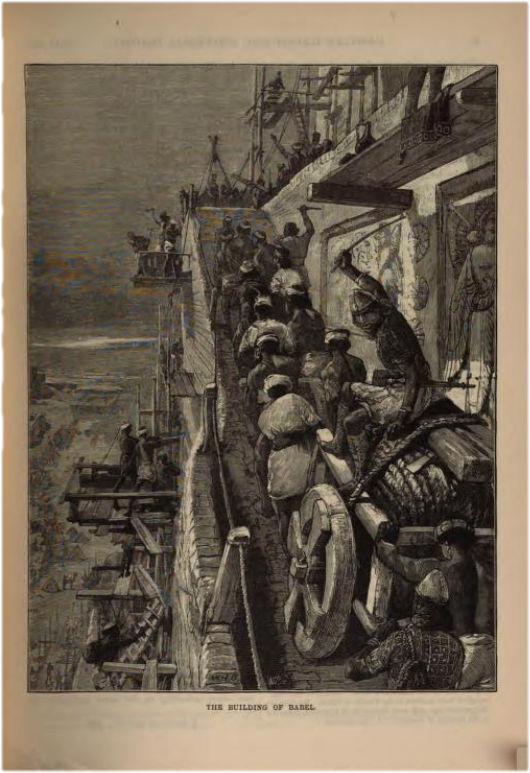
‘The Building of Babel’ – Cassell’s Illustrated Universal History, Edmund Ollier, 1882, p. 6
IMAGE LINKED: Cassell’s Illustrated Universal History Attribution 4.0 International (CC BY 4.0)
Throughout that brilliant essay, Ruskin shows how the violation of moral laws spoils the beauty of architecture, mars its usefulness, and makes it unstable.
He points out, with all the variations of emphasis, illustration, and appeal, that beauty is what is imitated from natural forms, consciously or unconsciously, and that what is not so derived, but depends for its dignity upon arrangement received from the human mind, expresses, while it reveals, the quality of the mind, whether it be noble or ignoble.
Thus: All building, therefore, shows man either as gathering or governing; and the secrets of his success are his knowing what to gather, and how to rule.
These are the two great intellectual Lamps of Architecture; the one consisting in a just and humble veneration of the works of God upon earth, and the other in an understanding of the dominion over those works which has been vested in man. [2]
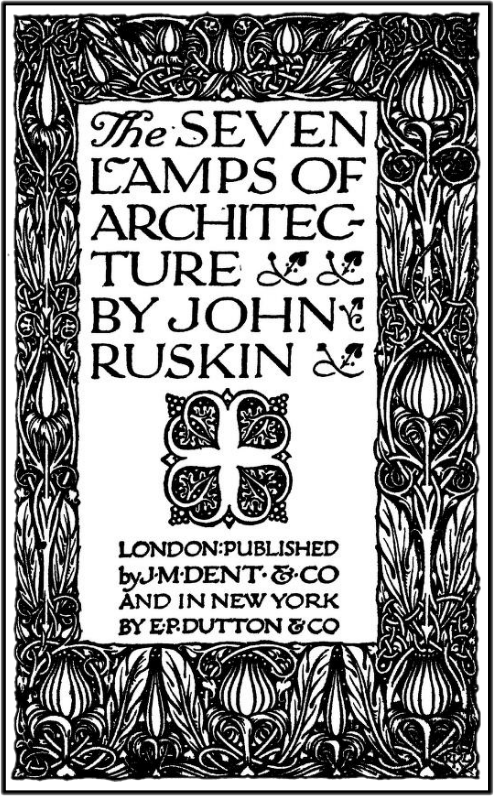
‘Frontispiece Seven Lamps of Architecture
IMAGE LINKED: Seven Lamps of Architecture Attribution 4.0 International (CC BY 4.0)
What our great prophet of art thus elaborated so eloquently, the early men forefelt by instinct, dimly it may be, but not less truly.
If architecture was born of need it soon showed its magic quality, and all true building touched depths of feeling and opened gates of wonder.
No doubt the men who first balanced one stone over two others must have looked with astonishment at the work of their hands and have worshiped the stones they had set up.
This element of mystical wonder and awe lasted long through the ages and is still felt when work is done in the old way by keeping close to nature, necessity, and faith.
From the first, ideas of sacredness, of sacrifice, of ritual rightness, of magic stability, of likeness to the universe, of perfection of form and proportion glowed in the heart of the builder and guided his arm.
[Christopher] Wren, philosopher as he was, decided that the delight of man in setting up columns was acquired through worshiping in the groves of the forest; and modern research has come to much the same view, for Sir Arthur Evans shows that in the first European age columns were gods.
All over Europe the early morning of architecture was spent in the worship of great stones. [3]
If we go to old Egypt, where the art of building seems first to have gathered power, and where its remains are best preserved, we may read the ideas of the earliest artists.
Long before the dynastic period a strong people inhabited the land who developed many arts which they handed on to the pyramid-builders.
Although only semi-naked savages using flint instruments in a style much like the Bushmen, they were the root, so to speak, of a wonderful artistic stock.
Of the Egyptians Herodotus said, “They gather the fruits of the earth with less labor than any other people.”
With agriculture and settled life came trade and stored-up energy which might essay to improve on caves and pits and other rude dwellings.
By the Nile, perhaps, man first aimed to overpass the routine of the barest need and obey his soul.
There he wrought out beautiful vases of fine marble, and invented square building.
At any rate, the earliest known structure actually discovered, a prehistoric tomb found in the sands at Hieraconpolis [sic] is already right-angled.
As [William] Lethaby reminds us, modern people take squareness very much for granted as being a self-evident form, but the discovery of the square was a great step in geometry. [4]
It opened a new era in the story of the builders. Early inventions must have seemed like revelations, as indeed they were, and it is not strange that skilled craftsmen were looked upon as magicians.
If man knows as much as he does, the discovery of the Square was a great event to the primitive mystics of the Nile.
Very early it became an emblem of truth, justice, and righteousness, and so it remains to this day though uncountable ages have passed. Simple, familiar, eloquent, it brings from afar a sense of the wonder of the dawn, and it still teaches a lesson which we find it hard to learn.
So also, the cube, the compasses, and the keystone, each a great advance for those to whom architecture was indeed “building touched with emotion,” as showing that its laws are the laws of the Eternal.
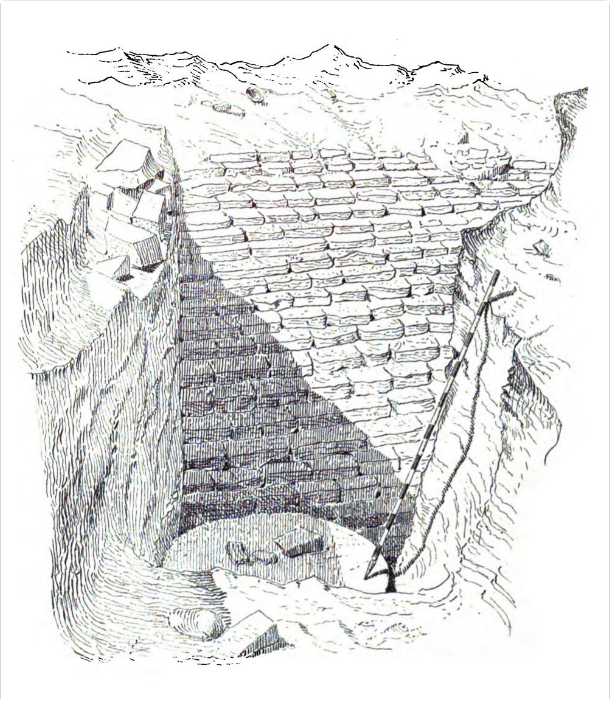
Hierakonpolis revetment of Temple basement – Hierakonopolis, Quibell, Green, Petrie, 1900
IMAGE LINKED: Quibell, Green, Petrie, 1900 Attribution 4.0 International (CC BY 4.0)
[Gaston] Maspero tells us that the temples of Egypt, even from earliest times, were built in the image of the earth as the builders had imagined it. [5]
For them the earth was a sort of flat slab more long than wide, and the sky was a ceiling or vault supported by four great pillars.
The pavement represented the earth; the four angles stood for the pillars; the ceiling, more often flat, though sometimes curved, corresponded to the sky.
From the pavement grew vegetation, and water plants emerged from the water; while the ceiling, painted dark blue, was strewn with stars of five points. Sometimes, the sun and moon were seen floating on the heavenly ocean escorted by the constellations, and the months and days.
There was a far withdrawn holy place, small and obscure, approached through a succession of courts and columned halls, all so arranged on a central axis as to point to the sunrise.
Before the outer gates were obelisks and avenues of statues.
Such were the shrines of the old solar religion, so oriented that on one day in the year the beams of the rising sun, or of some bright star that hailed his coming, should stream down the nave and illumine the altar. [6]
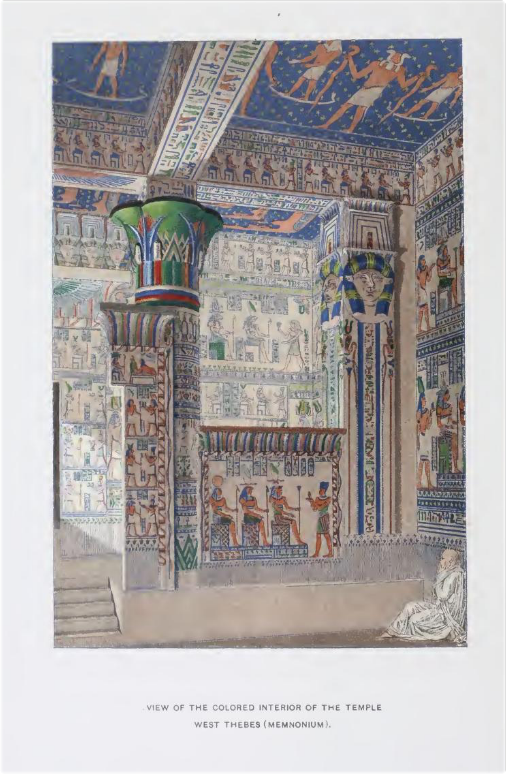
Interior of the Temple, Thebes, Memnonium – History of Egypt, Vol 2, Gaston Maspero, 1903
IMAGE LINKED: History of Egypt, Vol 2, Gaston Maspero, 1903 Attribution 4.0 International (CC BY 4.0)
Clearly, one ideal of the early builders was that of sacrifice, as seen in their use of the finest materials; and another was accuracy of workmanship.
Indeed, not a little of the earliest work displayed an astonishing technical ability, and such work must point to some underlying idea which the workers sought to realize.
Above all things they sought permanence. In later inscriptions relating to buildings, phrases like these occur frequently: “it is such as the heavens in all its quarters;” “firm as the heavens.”
Evidently the basic idea was that, as the heavens were stable, not to be moved, so a building put into proper relation with the universe would acquire magical stability.
It is recorded that when Ikhnaton founded his new city, four boundary stones were accurately placed, that so it might be exactly square, and thus endure forever.
Eternity was the ideal aimed at, everything else being sacrificed for that aspiration.
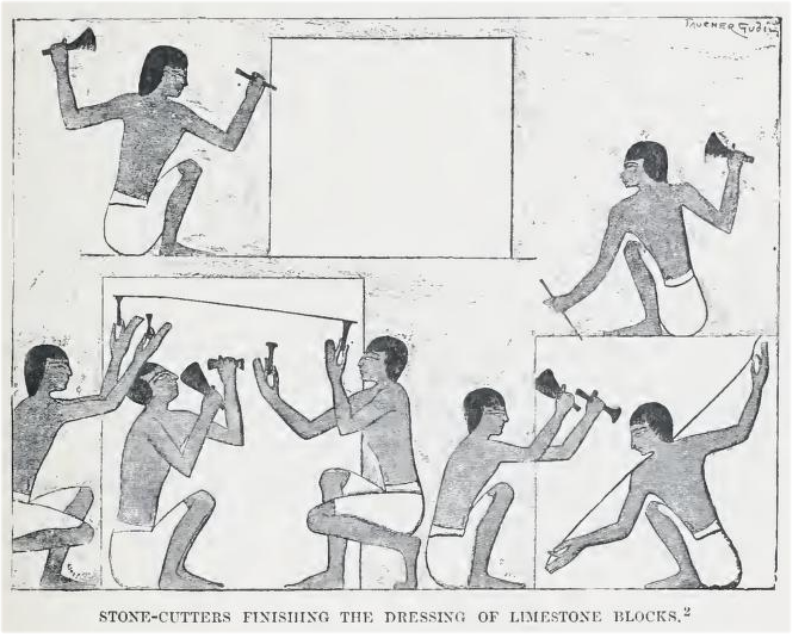
Drawn by Faucher-Gudin, from Rosellini, Monumenti civili, pl. xlviii. 2. featured in History of Egypt, Vol 2, Gaston Maspero, 1903, p. 99.
IMAGE LINKED: History of Egypt, Vol 2, Gaston Maspero, 1903 Attribution 4.0 International (CC BY 4.0)
How well they realized their dream is shown us in the Pyramids, of all monuments of mankind the oldest, the most technically perfect, the largest, and the most mysterious.
Ages come and go, empires rise and fall, philosophies flourish and fail, and man seeks him out many inventions, but they stand silent under the bright Egyptian night, as fascinating as they are baffling.
An obelisk is simply a pyramid, albeit the base has become a shaft, holding aloft the oldest emblems of solar faith—a Triangle mounted on a Square.
When and why this figure became holy no one knows *[see Ed. Note], save as we may conjecture that it was one of those sacred stones which gained its sanctity in times far back of all recollection and tradition, like the Kaaba at Mecca.
Whether it be an imitation of the triangle of zodiacal light, seen at certain times in the eastern sky at sunrise and sunset, or a feat of masonry used as a symbol of Heaven, as the Square was an emblem of Earth, no one may affirm. [7]
In the Pyramid Texts the Sun-god, when he created all the other gods, is shown sitting on the apex of the sky in the form of a Phoenix—that Supreme God to whom two architects, Suti and Hor, wrote so noble a hymn of praise. [8]
A Hymn of Praise to Amen when he riseth as Horus of the Two Horizons by Suti, the, Overseer of the Works of Amen, [and by] Her (Horus), the Overseer of the Works of Amen. They say:–Homage to thee, Ra, Beautiful (or Beneficent) One of every day! Thou shootest up at sunrise (or dawn) without fail, Khepera, great one of works. Thy radiance is in thy face, [thou] Unknown. [As for] shining metal, it doth not resemble thy splendours.
– British Museum Stele No. 475-9
White with the worship of ages, ineffably beautiful and pathetic, is the old light-religion of humanity—a sublime nature-mysticism in which Light was love and life, and Darkness evil and death.
For the early man light was the mother of beauty, the unveiler of color, the elusive and radiant mystery of the world, and his speech about it was reverent and grateful.
At the gates of the morning, he stood with uplifted hands, and the sun sinking in the desert at eventide made him wistful in prayer, half fear and half hope, lest the beauty return no more.
His religion, when he emerged from the night of animalism, was a worship of the Light—his temple hung with stars, his altar a glowing flame, his ritual a woven hymn of night and day.
No poet of our day, not even Shelley, has written lovelier lyrics in praise of the Light than those hymns of Ikhnaton [Akhenaten] in the morning of the world. [9]
Memories of this religion of the dawn linger with us today in the faith that follows the Day-Star from on high, and the Sun of Righteousness—One who is the Light of the World in life, and the Lamp of Poor Souls in the night of death.
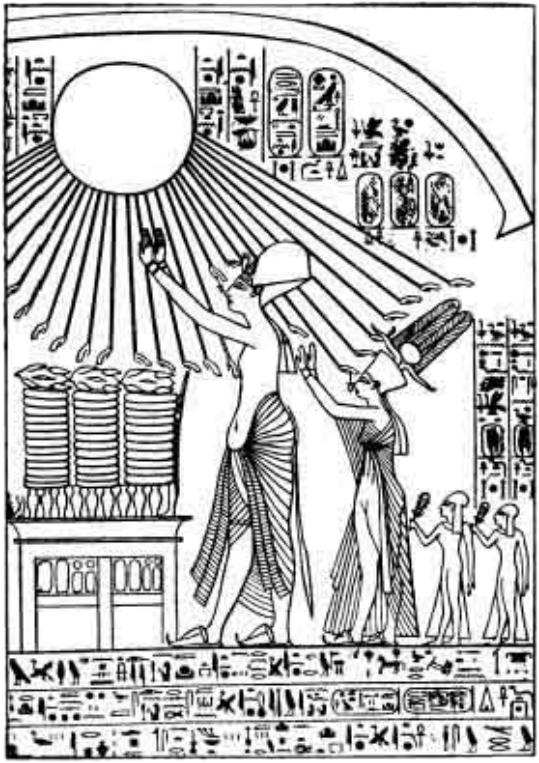
Amenhetep IV, accompanied by his queen and family, making offerings to Aten – from Tutankhamen, Amenism, Atenism and Egyptian Monotheism by E.A.W. Budge, 1923.
IMAGE LINKED: Tutankhamen, Amenism, Atenism and Egyptian Monotheism by E.A.W. Budge, 1923 Attribution 4.0 International (CC BY 4.0)
Here, then, are the real foundations of Masonry, both material and moral: in the deep need and aspiration of man, and his creative impulse; in his instinctive Faith, his quest of the Ideal, and his love of the Light.
Underneath all his building lay the feeling, prophetic of his last and highest thought, that the earthly house of his life should be in right relation with its heavenly prototype, the world-temple—imitating on earth the house not made with hands, eternal in the heavens.
If he erected a square temple, it was an image of the earth; if he built a pyramid, it was a picture of a beauty shown him in the sky; as, later, his cathedral was modelled after the mountain, and its dim and lofty arch a memory of the forest vista—its altar a fireside of the soul, its spire a prayer in stone.
And as he wrought his faith and dream into reality, it was but natural that the tools of the builder should become emblems of the thoughts of the thinker.
Not only his tools, but, as we shall see, the very stones with which he worked became sacred symbols—the temple itself a vision of that House of Doctrine, that Home of the Soul, which, though unseen, he is building in the midst of the years.
Footnotes
References
[1] Primitive Art in Egypt.
[2] Chapter iii, aphorism 2.
[3] Architecture, by Lethaby, chap. i
[4] Architecture, by Lethaby, chap. ii.
[5] Dawn of Civilisation.
[6] Dawn of Astronomy, Norman Lockyer.
[7] Churchward, in his Signs and Symbols of Primordial Man (chap. xv), holds that the pyramid was typical of heaven, Shu, standing on seven steps, having lifted the sky from the earth in the form of a triangle; and that at each point stood one of the gods, Sut and Shu at the base, the apex being the Pole Star where Horns of the Horizon had his throne. This is, in so far, true; but the pyramid emblem was older than Osiris, Isis, and Horns, and runs hack into an obscurity beyond knowledge.
[8] Religion and Thought in Egypt, by Breasted, lecture ix.
[9] Ikhnaton, indeed, was a grand, solitary, shining figure, “the first idealist in history,” and a poetic thinker in whom the religion of Egypt attained its highest reach. Dr. Breasted puts his lyrics alongside the poems of Wordsworth and the great passage of Ruskin in Modern Painters, as celebrating the divinity of Light (Religion and Thought in Egypt, lecture ix). Despite the revenge of his enemies, he stands out as a lonely, heroic, prophetic soul—”the first individual in time.”
Article by: Joseph Fort Newton
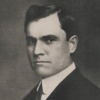
Rev. Newton (1880–1950) , was an American Baptist minister, authored a number of masonic books, including his best-known works, The Builders, published in 1914, and The Men’s House, published in 1923.
He received the third degree of Freemasonry on May 28, 1902 in Friendship Lodge No. 7, Dixon, Illinois, later affiliating with Mt. Hermon Lodge No. 263, Cedar Rapids, Iowa.
He also served as Grand Chaplain of the Grand Lodge of Iowa from 1911 to 1913 and Grand Prelate of the Grand Encampment of Knights Templar.
The Builders has been called "an outstanding classic in Masonic literature offering the early history of Freemasonry."


The Seven Lamps of Architecture
By: John Ruskin (Author)
The Seven Lamps of Architecture is a classic architecture history text by John Ruskin. The reader will perhaps be surprised by the small number of buildings to which reference has been made.
But it is to be remembered that the following chapters pretend only to be a statement of principles, illustrated each by one or two examples, not an essay on European architecture; and those examples I have generally taken either from the buildings which I love best, or from the schools of architecture which, it appeared to me, have been less carefully described than they deserved.

Signs & Symbols of Primordial Man
By: Albert Churchward (Author)
The Evolution of Religious Doctrines From the Eschatology of the Ancient Egyptians.
“In writing the explanation of the Signs and Symbols of Primordial Man, I have gone back to the foundation of the human as a beginning, and traced these signs from the first Pygmies, and their then meaning, up to the latter-day Christians, and shown the evolution and meaning of the same, back to the Primordial Signs and Symbols and Sign Language, which have never been studied or taken into account either in Freemasonry, the Christian doctrines or the Eschatology of the Egyptians.”
Partial Contents:
Freemasonry Generally, Totemism;
Hieroglyphics;
Remains of Ritual found amongst the Zapotecs, Mexicans, People of Yucatan and Central America;
Myths and Legends same as Egyptian;
Tribes of West Africa;
Birthplace of Man and various Exodes;
The Pygmies; Druids and Israelites;
Chaldeans;
Origin of the Zodiac;
Oriental Origins;
The Incas;
The Buddhists;
Steller to Solar Mythos;
Origins and Explanations of Others

Architecture Mysticism And Myth (Illustrated)
By: W.R. Lethaby (Author)
Published in 1892, this book looks at the symbolism of architecture, both in real life and in myth.
Fully illustrated, chapters include The World Fabric, The Microcosmos, The Planetary Spheres, The Labyrinth, Four Square and The Symbol Of Creation.
Global Grey editions are fully formatted and always have linked table of contents and cover page.
Footnotes and illustrations are included when applicable.
Recent Articles: The Builders by Joseph Fort Newton
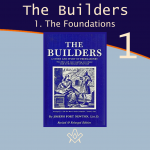 The Builders – 1 The Foundations Chapter 1. The Foundations Explore an outstanding classic in Masonic literature - an exposition of the early history and symbolism of Freemasonry – from the foundations upwards. |
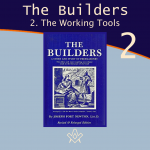 The Builders – 2 The Working Tools Chapter 2. The Working Tools - Explore an outstanding classic in Masonic literature - an exposition of the early history and symbolism of Freemasonry – from the foundations upwards. |
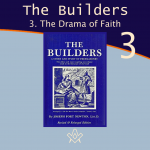 The Builders – 3 The Drama of Faith Chapter 3. The Drama of Faith - Explore an outstanding classic in Masonic literature - an exposition of the early history and symbolism of Freemasonry – from the foundations upwards. |
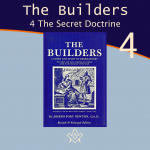 The Builders – 4 The Secret Doctrine Chapter 4. The Secret Doctrine - Explore an outstanding classic in Masonic literature - an exposition of the early history and symbolism of Freemasonry – from the foundations upwards. By Joseph Fort Newton |
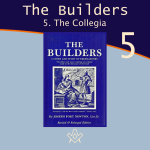 Chapter 5. The Collegia - If the laws of building were secrets known only to initiates, there must have been a secret Order of architects who built the temple of Solomon. Who were they? |
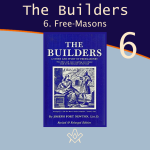 The Builders – 6 The Free-Masons Chapter 6. the Free-Masons - an examination into the history of the medieval guilds, their charges and regulations that form the base for the allegories and symbols in our modern versions of masonic craft ritual. By Joseph Fort Newton |
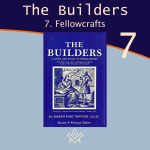 Chapter 7. the Fellowcrafts - an examination into the history of the medieval guilds, their charges and regulations that form the base for the allegories and symbols in our modern versions of masonic craft ritual. By Joseph Fort Newton |
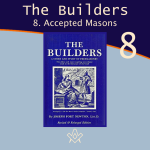 The Builders – 8 Accepted Masons Chapter 8. Accepted Masons - an examination into the history of accepted masons, and why did soldiers, scholars, antiquarians, clergymen, lawyers, and even the nobility ask to be accepted as members of the order of Free-masons? By Joseph Fort Newton |
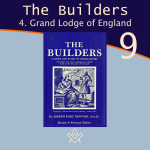 The Builders – 9 Grand Lodge of England Chapter 9. Grand Lodge of England - From every point of view, the organization of the Grand Lodge of England, in 1717, was a significant and far-reaching event. By Joseph Fort Newton |
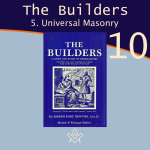 The Builders – 10 Universal Masonry Chapter 10. Universal Masonry - Henceforth, the Masons of England were no longer a society of handicraftsmen, but an association of men of all orders and every vocation, as also of almost every creed, |
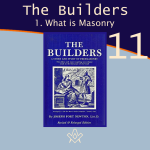 The Builders – 11 What is Masonry Chapter 11 "Masonry is the activity of closely united men who, employing symbolical forms borrowed principally from the mason's trade and from architecture, work for the welfare of mankind, striving morally to ennoble themselves and others, and thereby to bring about a universal league of mankind, which they aspire to exhibit even now on a small scale." |
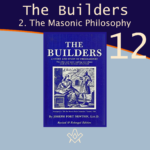 The Builders – 12 The Masonic Philosophy Chapter 12 When we look at Masonry in this large and mellow light, it is like a stately old cathedral, gray with age, rich in associations, its steps worn by innumerable feet of the living and the dead—not piteous, but strong and enduring. By Joseph Fort Newton |
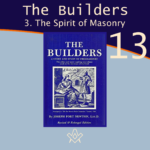 The Builders – 13 The Spirit of Masonry Chapter 13 Masonry is Friendship—friendship, first, with the great Companion, of whom our own hearts tell us, who is always nearer to us than we are to our-selves, and whose inspiration and help is the greatest fact of human experience. |
masonic knowledge
to be a better citizen of the world
share the square with two brothers

click image to open email app on mobile device


